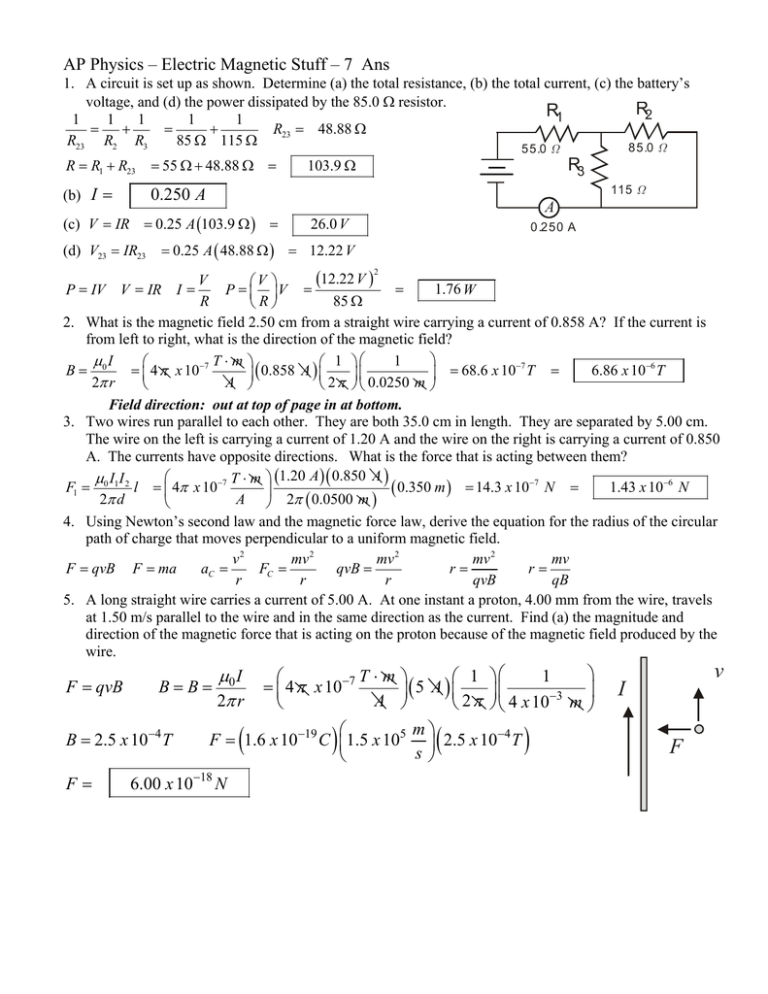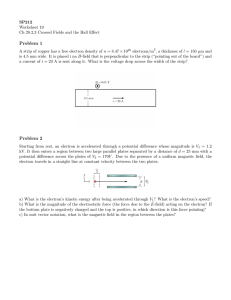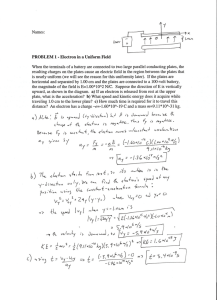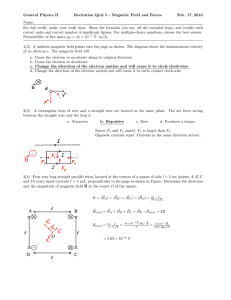Homework 7 ans - SwansonPhysics.com
advertisement

AP Physics – Electric Magnetic Stuff – 7 Ans 1. A circuit is set up as shown. Determine (a) the total resistance, (b) the total current, (c) the battery’s voltage, and (d) the power dissipated by the 85.0 resistor. R2 R1 1 1 1 1 1 R23 48.88 R23 R2 R3 85 115 85.0 W 5 5.0 W R R1 R23 55 48.88 (b) I 0.250 A R3 115 W (c) V IR 0.25 A 103.9 (d) V23 IR23 103.9 A 26.0 V 0 .2 50 A 0.25 A 48.88 12.22 V 12.22 V V V 1.76 W P IV V IR I P V R 85 R 2. What is the magnetic field 2.50 cm from a straight wire carrying a current of 0.858 A? If the current is from left to right, what is the direction of the magnetic field? I Tm 1 1 7 4 x 107 B 0 6.86 x 106 T 68.6 x 10 T 0.858 A 2 r A 2 0.0250 m Field direction: out at top of page in at bottom. 3. Two wires run parallel to each other. They are both 35.0 cm in length. They are separated by 5.00 cm. The wire on the left is carrying a current of 1.20 A and the wire on the right is carrying a current of 0.850 A. The currents have opposite directions. What is the force that is acting between them? II T m 1.20 A 0.850 A F1 0 1 2 l 4 x 107 1.43 x 106 N 0.350 m 14.3 x 107 N 2 d A 2 0.0500 m 4. Using Newton’s second law and the magnetic force law, derive the equation for the radius of the circular path of charge that moves perpendicular to a uniform magnetic field. mv 2 v2 mv 2 mv 2 mv r aC FC qvB r F qvB F ma qvB r r r qB 5. A long straight wire carries a current of 5.00 A. At one instant a proton, 4.00 mm from the wire, travels at 1.50 m/s parallel to the wire and in the same direction as the current. Find (a) the magnitude and direction of the magnetic force that is acting on the proton because of the magnetic field produced by the wire. 2 F qvB B 2.5 x 104 T F Tm 1 1 4 x 107 5 A 2 3 A 4 x 10 m m F 1.6 x 1019 C 1.5 x 105 2.5 x 104 T s BB 0 I 2 r 6.00 x 1018 N v I F 6. In a television set, electrons are accelerated from rest through a potential difference in an electron gun. 0.0400 m They then pass through deflecting plates before striking 0.500 m the screen. (a) Determine the potential difference through which the electrons must be accelerated in the 0.012 m electron gun in order to have a speed of 6.0 x 107 m/s Electron beam when they enter the deflecting plates. 1 mv 2 qV mv 2 V Screen 2 2q 9.11 x 1031 kg 6.0 x 107 ms V 2 1.60 x 1019 C 2 102 x 102 V 1.02 x 104 V The pair of horizontal plates shown to the right is used to deflect electrons up or down in the television set by placing a potential difference across them. The plates have a length of 0.0400 m and a separation of 0.012 m, and the right edge of the plates is 0.500 m from the screen. A potential difference of 200.0 V is applied across the plates, and the electrons are deflected toward the top of the screen. Assume the electrons enter the plates with a speed of 6.0 x 107 m/s and the fringing at the edges of the plates and gravity are negligible. (b) Which plate in the pair must be at the higher potential for the electrons to be deflected upward? Justify your answer. Upper plate, electron will be attracted to it. (c) Considering only an electron’s motion as it moves through the space between the plates, compute the following: d d i. The time for the electron to move through the plates. v t t v 0.0400 m t 6.67 x 1010 s 0.00667 x 107 s m 6.0 x 107 s F ii. The vertical displacement of the electron while it is between the plates. E F Eq q qV qV V V F ma F Eq F q ma a E d md d d 1.6 x 10 a 9.11 x 10 y 1 2 at 2 19 31 C 200 V kg 0.012 m 2927 x 1012 m s2 2 1 m 2.93 x 1015 2 6.67 x 1010 s 2 s 2.93 x 1015 m s2 65.2 x 105 m 6.52 x 104 m iii. Why is it reasonable to ignore gravity? Gravity is billions of times weaker. iv. Describe the path of the electrons from when they leave the plate until they hit the screen. State a reason for your answer. Straight line path, no forces act on them, so, from first law, they go straight.



